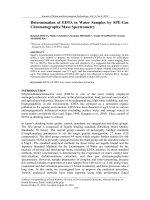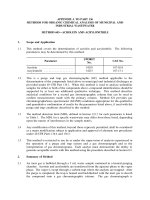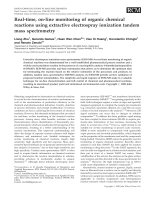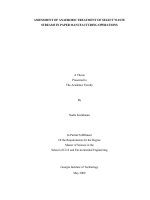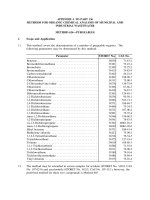Ionization Methods in Organic Mass Spectrometry pot
Bạn đang xem bản rút gọn của tài liệu. Xem và tải ngay bản đầy đủ của tài liệu tại đây (98.92 KB, 19 trang )
Ionization Methods in Organic
Mass Spectrometry
Contents:
. Introduction
. Gas-Phase Ionization
. Electron Ionization (EI)
. Chemical Ionization (CI)
. Desorption Chemical Ionization (DCI)
. Negative-ion chemical ionization
. Field Desorption and Ionization
. Field Desorption (FD)
. Field Ionization (FI)
. Particle Bombardment
. Fast Atom Bombardment (FAB)
. Secondary Ion Mass Spectrometry (SIMS)
. Atmospheric Pressure Ionization
. Electrospray Ionization (ESI)
. Atmospheric Pressure Chemical Ionization (APCI)
. Laser Desorption
. Matrix-Assisted Laser Desorption Ionization (MALDI)
. Appendices
. CI Reagent Gases
. Direct Formation of Negative Ions
. FAB matrices
Introduction
A mass spectrometer works by using magnetic and electric fields to exert forces on charged par-
ticles (ions) in a vacuum. Therefore, a compound must be charged or ionized to be analyzed by a
mass spectrometer. Furthermore, the ions must be introduced in the gas phase into the vacuum
system of the mass spectrometer. This is easily done for gaseous or heat-volatile samples. How-
ever, many (thermally labile) analytes decompose upon heating. These kinds of samples require
either desorption or desolvation methods if they are to be analyzed by mass spectrometry. Al-
though ionization and desorption/desolvation are usually separate processes, the term "ionization
method" is commonly used to refer to both ionization and desorption (or desolvation) methods.
The choice of ionization method depends on the nature of the sample and the type of information
required from the analysis. So-called 'soft ionization' methods such as field desorption and elec-
trospray ionization tend to produce mass spectra with little or no fragment-ion content.
Gas-Phase Ionization
These methods rely upon ionizing gas-phase samples. The samples are usually introduced
through a heated batch inlet, heated direct insertion probe, or a gas chromatograph.
Electron Ionization (EI)
Summary
Also referred to as electron impact ionization, this is the oldest and best-characterized of all the
ionization methods. A beam of electrons passes through the gas-phase sample. An electron that
collides with a neutral analyte molecule can knock off another electron, resulting in a positively
charged ion. The ionization process can either produce a molecular ion which will have the same
molecular weight and elemental composition of the starting analyte, or it can produce a fragment
ion which corresponds to a smaller piece of the analyte molecule.
The ionization potential is the electron energy that will produce a molecular ion. The appearance
potential for a given fragment ion is the electron energy that will produce that fragment ion.
Most mass spectrometers use electrons with an energy of 70 electron volts (eV) for EI. Decreas-
ing the electron energy can reduce fragmentation, but it also reduces the number of ions formed.
Sample introduction
. heated batch inlet
. heated direct insertion probe
. gas chromatograph
. liquid chromatograph (particle-beam interface)
Benefits
. well-understood
. can be applied to virtually all volatile compounds
. reproducible mass spectra
. fragmentation provides structural information
. libraries of mass spectra can be searched for EI mass spectral "fingerprint"
Limitations
. sample must be thermally volatile and stable
. the molecular ion may be weak or absent for many compounds.
Mass range
. Low Typically less than 1,000 Da.
Chemical Ionization (CI)
Summary
Chemical ionization uses ion-molecule reactions to produce ions from the analyte. The chemical
ionization process begins when a reagent gas such as methane, isobutane, or ammonia is ionized
by electron impact. A high reagent gas pressure (or long reaction time) results in ion-molecule
reactions between the reagent gas ions and reagent gas neutrals. Some of the products of these
ion-molecule reactions can react with the analyte molecules to produce analyte ions.
Example (R = reagent, S = sample, e = electron, . = radical electron , H = hydrogen):
R + e > R+. + 2e
R+. + RH > RH+ + R.
RH+ + S > SH+ + R
(of course, other reactions can occur)
Sample introduction
. heated batch inlet
. heated direct insertion probe
. gas chromatograph
. liquid chromatograph (particle-beam interface)
Benefits
. often gives molecular weight information through molecular-like ions such as [M+H]+,
even when EI would not produce a molecular ion.
. simple mass spectra, fragmentation reduced compared to EI
Limitations
. sample must be thermally volatile and stable
. less fragmentation than EI, fragment pattern not informative or reproducible enough for
library search
. results depend on reagent gas type, reagent gas pressure or reaction time, and nature of
sample.
Mass range
. Low Typically less than 1,000 Da.
Desorption Chemical Ionization (DCI)
Summary
This is a variation on chemical ionization in which the analyte is placed on a filament that is rap-
idly heated in the CI plasma. The direct exposure to the CI reagent ions, combined with the rapid
heating acts to reduce fragmentation. Some samples that cannot be thermally desorbed without
decomposition can be characterized by the fragments produced by pyrolysis DCI.
Sample introduction
. sample deposited onto a filament wire
. filament rapidly heated inside the CI source.
Benefits
. reduced thermal decomposition
. rapid analysis
. relatively simple equipment
Limitations
. not particularly reproducible
. rapid heating requires fast scan speeds
. fails for large or labile compounds
Mass range
Low Typically less than 1,500 Da.
Negative-ion chemical ionization (NCI)
Summary
Not all compounds will produce negative ions. However, many important compounds of envi-
ronmental or biological interest can produce negative ions under the right conditions. For such
compounds, negative ion mass spectrometryis more efficient, sensitive and selective than
positive-ion mass spectrometry.
Negative ions can be produced by a number of processes. Resonance electron capture refers to
the capture of an electron by a neutral molecule to produce a molecular anion. The electron en-
ergy is very low, and the specific energy required for electron capture depends on the molecular
structure of the analyte.
Electron attachment is an endothermic process, so the resulting molecular anion will have excess
energy. Some molecular anions can accommodate the excess energy. Others may lose the elec-
tron or fall apart to produce fragment anions.
In negative-ion chemical ionization, a buffer gas (usually a common CI gas such as methane) is
used to slow down the electrons in the electron beam until some of the electrons have just the
right energy to be captured by the analyte molecules. The buffer gas can also help stabilize the
energetic anions and reduce fragmentation. This is really a physical process and not a true
"chemical ionization" process.
Sample introduction
. Same as for CI
Benefits
. efficient ionization, high sensitivity
. less fragmentation than positive-ion EI or CI
. greater selectivity for certain environmentally or biologically important compounds
Limitations
. not all volatile compounds produce negative ions
. poor reproducibility
Mass range
. Low Typically less than 1,000 Da.
Field Desorption and Ionization
These methods are based on electron tunneling from an emitter that is biased at a high electrical
potential. The emitter is a filament on which fine crystalline 'whiskers' are grown. When a high
potential is applied to the emitter, a very high electric field exists near the tips of the whiskers.
There are two kinds of emitters used on JEOL mass spectrometers: carbon emitters and silicon
emitters. Silicon emitters are robust, relatively inexpensive, and they can handle a higher current
for field desorption. Carbon emitters are more expensive, but they can provide about an order of
magnitude better sensitivity than silicon emitters.
Field desorption and ionization are soft ionization methods that tend to produce mass spectra
with little or no fragment-ion content.
Field Desorption (FD)
Summary
The sample is deposited onto the emitter and the emitter is biased to a high potential (several
kilovolts) and a current is passed through the emitter to heat up the filament. Mass spectra are
acquired as the emitter current is gradually increased and the sample is evaporated from the emit-
ter into the gas phase. The analyte molecules are ionized by electron tunneling at the tip of the
emitter 'whiskers'. Characteristic positive ions produced are radical molecular ions and cation-
attached species such as [M+Na]+ and [M-Na]+. The latter are probably produced during desorp-
tion by the attachment of trace alkali metal ions present in the analyte.
Sample introduction
Direct insertion probe.
The sample is deposited onto the tip of the emitter by
. dipping the emitter into an analyte solution
. depositing the dissolved or suspended sample onto the emitter with a microsyringe
Benefits
. simple mass spectra, typically one molecular or molecular-like ionic species per com-
pound.
. little or no chemical background
. works well for small organic molecules, many organometallics, low molecular weight
polymers and some petrochemical fractions
Limitations
. sensitive to alkali metal contamination and sample overloading
. emitter is relatively fragile
. relatively slow analysis as the emitter current is increased
. the sample must be thermally volatile to some extent to be desorbed
Mass range
. Low-moderate, depends on the sample. Typically less than about 2,000 to 3,000 Da.
. some examples have been recorded from ions with masses beyond 10,000 Da.
Field Ionization (FI)
Summary
The sample is evaporated from a direct insertion probe, gas chromatograph, or gas inlet. As the
gas molecules pass near the emitter, they are ionized by electron tunneling.
Sample introduction
. heated direct insertion probe
. gas inlet
. gas chromatograph
Benefits
. simple mass spectra, typically one molecular or molecular-like ionic species per com-
pound.
. little or no chemical background
. works well for small organic molecules and some petrochemical fractions
Limitations
. The sample must be thermally volatile. Samples are introduced in the same way as for
electron ionization (EI).
Mass range
. Low Typically less than 1000 Da.
Particle Bombardment
In these methods, the sample is deposited on a target that is bombarded with atoms, neutrals, or
ions. The most common approach for organic mass spectrometry is to dissolve the analyte in a
liquid matrix with low volatility and to use a relatively high current of bombarding particles
(FABor dynamic SIMS). Other methods use a relatively low current of bombarding particles and
no liquid matrix (static SIMS). The latter methods are more commonly used for surface analysis
than for organic mass spectrometry.
The primaryparticle beam is the bombarding particle beam, while the secondary ions are the ions
produced from bombardment of the target.
Fast Atom Bombardment (FAB)
Summary
The analyte is dissolved in a liquid matrix such as glycerol, thioglycerol, m-nitrobenzyl alcohol,
or diethanolamine and a small amount (about 1 microliter) is placed on a target. The target is
bombarded with a fast atom beam (for example, 6 keV xenon atoms) that desorb molecular-like
ions and fragments from the analyte. Cluster ions from the liquid matrix are also desorbed and
produce a chemical background that varies with the matrix used.
Sample introduction
. direct insertion probe
. LC/MS (frit FAB or continuous-flow FAB).
Benefits
. rapid
. simple
. relatively tolerant of variations in sampling
. good for a large variety of compounds
. strong ion currents good for high-resolution measurements
Limitations
. high chemical background defines detection limits
. may be difficult to distinguish low-molecular-weight compounds from chemical back-
ground
. analyte must be soluble in the liquid matrix
. no good for multiply charged compounds with more than 2 charges
Mass range
. Moderate Typically ~300 Da to about 6000 Da.
Secondary Ion Mass Spectrometry (SIMS)
This discussion refers to dynamic SIMS.
Summary
Dynamic SIMS is nearly identical to FAB except that the primary particle beam is an ion beam
(usually cesium ions) rather than a neutral beam. The ions can be focused and accelerated to
higher kinetic energies than are possible for neutral beams, and sensitivity is improved for higher
masses.
The use of SIMS for moderate-size (3000-13,000 Da) proteins and peptides has largely been
supplanted by electrospray ionization.
Sample introduction
. Same as for FAB
Benefits
. Same as for FAB, except sensitivity is improved for higher masses (3000 to 13,000 Da).
Limitations
. Same as for FAB except
. target can get hotter than in FAB due to more energetic primary beam
. high-voltage arcs more common than FAB
. ion source usually requires more maintenance than FAB
Mass range
. Moderate Typically 300 to 13,000 Da.
Atmospheric Pressure Ionization (Spray Methods)
In these methods, a solution containing the analyte is sprayed at atmospheric pressure into an in-
terface to the vacuum of the mass spectrometer ion source. A combination of thermal and pneu-
matic means is used to desolvate the ions as they enter the ion source. Solution flow rates can
range from less than a microliter per minute to several milliliters per minute. These methods are
well-suited for flow-injection and LC/MS techniques.
Electrospray Ionization (ESI)
Summary
The sample solution is sprayed across a high potential difference (a few kilovolts) from a needle
into an orifice in the interface. Heat and gas flows are used to desolvate the ions existing in the
sample solution.
Electrospray ionization can produce multiply charged ions with the number of charges tending to
increase as the molecular weight increases. The number of charges on a given ionic species must
be determined by methods such as:
. comparing two charge states that differ by one charge and solving simultaneous equa-
tions
. looking for species that have the same charge but different adduct masses
. examining the mass-to-charge ratios for resolved isotopic clusters
Sample introduction
. flow injection
. LC/MS
. typical flow rates are less than 1 microliter per minute up to about a milliliter per minute
Benefits
. good for charged, polar or basic compounds
. permits the detection of high-mass compounds at mass-to-charge ratios that are easily
determined by most mass spectrometers (m/z typically less than 2000 to 3000).
. best method for analyzing multiply charged compounds
. very low chemical background leads to excellent detection limits
. can control presence or absence of fragmentation by controlling the interface lens po-
tentials
. compatible with MS/MS methods
Limitations
. multiply charged species require interpretation and mathematical transformation (can
sometimes be difficult)
. complementary to APCI. No good for uncharged, non-basic, low-polarity compounds
(e.g.steroids)
. very sensitive to contaminants such as alkali metals or basic compounds
. relatively low ion currents
. relatively complex hardware compared to other ion sources
Mass range
. Low-high Typically less than 200,000 Da.
Atmospheric Pressure Chemical Ionization (APCI)
Summary
Similar interface to that used for ESI. In APCI, a corona discharge is used to ionize the analyte in
the atmospheric pressure region. The gas-phase ionization in APCI is more effective than ESI for
analyzing less-polar species. ESI and APCI are complementary methods.
Sample introduction
. same as for electrospray ionization
Benefits
. good for less-polar compounds
. excellent LC/MS interface
. compatible with MS/MS methods
Limitations
. complementary to ESI.
Mass range
. Low-moderate Typically less than 2000 Da.
Laser Desorption
Laser desorption methods use a pulsed laser to desorb species from a target surface. Therefore,
one must use a mass analyzer such as time-of-flight (TOF) or Fourier transform ion cyclotron
resonance (FTICR) that is compatible with pulsed ionization methods. Magnetic sector mass
spectrometers equipped with an array detector can also be used for the detection of ions pro-
duced by MALDI.
Direct laser desorption relies on the very rapid heating of the sample or sample substrate to va-
porize molecules so quickly that they do not have time to decompose. This is good for low to
medium-molecular weight compounds and surface analysis. The more recent development of
matrix-assisted laser desorption ionization (MALDI) relies on the absorption of laser energy by a
matrix compound. MALDI has become extremely popular as a method for the rapid determina-
tion of high-molecular-weight compounds.
Matrix-Assisted Laser Desorption Ionization (MALDI)
Summary
The analyte is dissolved in a solution containing an excess of a matrix such as sinapinic acid or
dihydroxybenzoic acid that has a chromophore that absorbs at the laser wavelength. A small
amount of this solution is placed on the laser target. The matrix absorbs the energy from the laser
pulse and produces a plasma that results in vaporization and ionization of the analyte.
Sample introduction
. direct insertion probe
. continuous-flow introduction
Benefits
. rapid and convenient molecular weight determination
Limitations
. MS/MS difficult
. requires a mass analyzer that is compatible with pulsed ionization techniques
. not easily compatible with LC/MS
Mass range
. Very high Typically less than 500,000 Da.
Appendices:
CI Reagent Gases
Methane:
. good for most organic compounds
. usually produces [M+H]+, [M+CH3]+ and [M+C3H5]+ adducts
. adducts are not always abundant
. extensive fragmentation
Isobutane:
. usually produces [M+H]+, [M+C4H9]+ adducts and some fragmentation
. adducts are relatively more abundant than for methane CI
. not as universal as methane
Ammonia:
. fragmentation virtually absent
. polar compounds produce [M+NH4]+ adducts
. basic compounds produce [M+H]+ adducts
. non-polar and non-basic compounds are not ionized
. Click here to view a JPEG file (~19K bytes) that shows a positive-ion CI reagent-gas
mass spectrum of ammonia
Direct formation of negative ions - a better approach to NCI
?
By directly controlling the energy of the ionizing electrons, one can select the exact electron en-
ergy required for electron capture or fragment ion formation from a specific compound. This
avoids the problems associated with the NCI approach, where the ionizing plasma can contain
electrons with poorly defined energies as well as neutral molecules and other ionic species. JEOL
USA, Inc. is supporting research using a patented electron monochromator that has been devel-
oped by J. Laramee, M. Deinzer and coworkers at Oregon State University. This device will al-
low the ionizing electron energy to be precisely controlled for negative-ion mass spectrometry,
leading to more sensitive, selective, and reproducible mass spectra for environmentally important
compounds.
FAB matrices
glycerol
. C3H8O3, m/z 92.0473
. first and most widely-used FAB matrix.
. best choice for polar compounds
1-thioglycerol
. C3H8O2S, m/z 108.0245
. similar uses to glycerol, but may enhance M+1 abundance
. more volatile than glycerol, evaporates quickly
3-nitrobenzyl alcohol (NBA)
. C7H7NO3, m/z 153.0416
. best choice for less polar compounds ( e.g. chlorophyll) and many organometallics
2-nitrophenyl octyl ether (NPOE)
. C14H21NO3, m/z 251.1521
. only FAB matrix with no reactive hydrogen
. good choice for reactive compounds such as organometallics
Note: this example contains trace PEG 600 contamination
triethanolamine
. C6H15NO3, m/z 149.1052
. good matrix for negative-ion FAB
. enhances [M-H]- formation.
"magic bullet"
. 5:1 mixture of dithiothreitol and dithioerythritol (DL-threo- and erythro-1,4-
dimercapto-2,3-butanediol)
. C4H10S2O2, m/z 154.0122
dioctyl phthalate (DOP)
. bis(2-ethylhexyl) phthalate
. C24H38O4, m/z 390.54
. Similar in use to NPOE
. Widespread contaminant in solvents, gives characteristic 149 peak in EI mass spectra
. Use care to avoid contaminating the mass spectrometer
sulfuric acid
. H2SO4, m/z 97.967384
. good for some inorganics and organometallics (e.g. copper phthalocyanine)
. corrosive, use care
